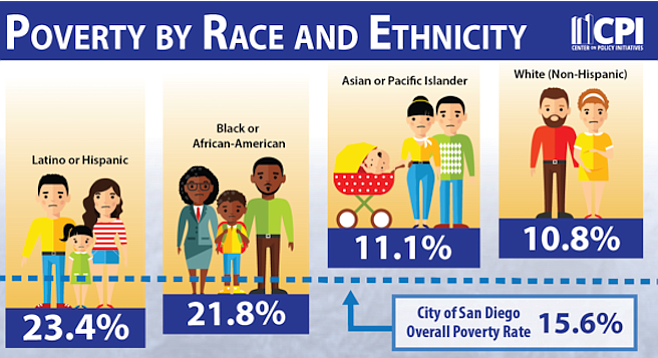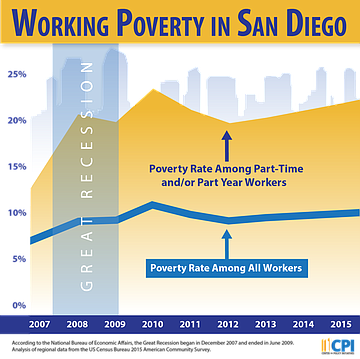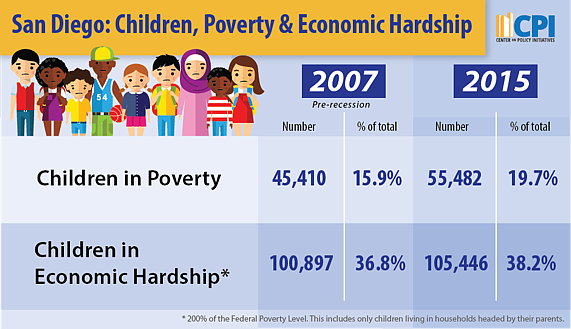 Facebook
Facebook
 X
X
 Instagram
Instagram
 TikTok
TikTok
 Youtube
Youtube

Last year, 15.6 percent of the City of San Diego's population was living below the poverty rate, almost unchanged from 15.7 percent in 2014, according to United States Census Bureau numbers released today (September 15).

Median family income was $67.871, essentially unchanged from 2014's $67,879, noted Peter Brownell, research director of San Diego's Center on Policy Initiatives.
Earlier this week, economists were exulting that United States income gains are finally going to the middle class. However, the inflation-adjusted incomes of most American households are still smaller than in the late 1990s, according to the New York Times.
San Diego median household incomes topped the nation's last year — $67,871 to $56,516, but San Diego's cost of living is more than 42 percent higher — much worse than the nation's. Kelly Cunningham, an economist connected with National University, suspects that the San Diego poverty rate "is actually higher than it is portrayed" because of the high cost of living here.
Because of that high cost of living, "Families have to make impossible choices and sacrifices to survive," says Kyra Greene, deputy director of the Center for Policy Initiatives.

Brownell points out that race and ethnicity make a huge difference. Last year's poverty rate was 23.4 percent for Latinos and Hispanics and 21.8 percent for blacks and African-Americans; that compares with 10.8 percent for whites (non-Hispanic) and 11.1 percent for Asians and Pacific Islanders.
Brownell notes that Detroit's poverty rate last year was 39.8 percent and Cleveland's was 34.7 percent. "Housing costs are very different across these cities, so the 39.8 percent of people in poverty in Detroit would be more likely to find housing they can afford than the…15.6 percent of people below that income level in San Diego." He adds, "The 15.6 percent here is more severe than 15 percent in Mississippi, where housing costs" are low.
The poverty rate in San Jose was a mere 9.5 percent in San Jose last year, but median housing prices are above a million dollars.
The Census Bureau provides data on household incomes that are below 200 percent above the federal poverty level. This can be called the "near-poverty level." Almost one-third of San Diego's children live in near-poverty, says Brownell.


Last year, 15.6 percent of the City of San Diego's population was living below the poverty rate, almost unchanged from 15.7 percent in 2014, according to United States Census Bureau numbers released today (September 15).

Median family income was $67.871, essentially unchanged from 2014's $67,879, noted Peter Brownell, research director of San Diego's Center on Policy Initiatives.
Earlier this week, economists were exulting that United States income gains are finally going to the middle class. However, the inflation-adjusted incomes of most American households are still smaller than in the late 1990s, according to the New York Times.
San Diego median household incomes topped the nation's last year — $67,871 to $56,516, but San Diego's cost of living is more than 42 percent higher — much worse than the nation's. Kelly Cunningham, an economist connected with National University, suspects that the San Diego poverty rate "is actually higher than it is portrayed" because of the high cost of living here.
Because of that high cost of living, "Families have to make impossible choices and sacrifices to survive," says Kyra Greene, deputy director of the Center for Policy Initiatives.

Brownell points out that race and ethnicity make a huge difference. Last year's poverty rate was 23.4 percent for Latinos and Hispanics and 21.8 percent for blacks and African-Americans; that compares with 10.8 percent for whites (non-Hispanic) and 11.1 percent for Asians and Pacific Islanders.
Brownell notes that Detroit's poverty rate last year was 39.8 percent and Cleveland's was 34.7 percent. "Housing costs are very different across these cities, so the 39.8 percent of people in poverty in Detroit would be more likely to find housing they can afford than the…15.6 percent of people below that income level in San Diego." He adds, "The 15.6 percent here is more severe than 15 percent in Mississippi, where housing costs" are low.
The poverty rate in San Jose was a mere 9.5 percent in San Jose last year, but median housing prices are above a million dollars.
The Census Bureau provides data on household incomes that are below 200 percent above the federal poverty level. This can be called the "near-poverty level." Almost one-third of San Diego's children live in near-poverty, says Brownell.
Comments